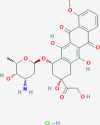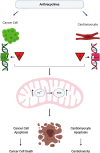Epigenetic Changes Associated With Anthracycline-Induced Cardiotoxicity
- PMID: 32770710
- PMCID: PMC7877852
- DOI: 10.1111/cts.12857
Epigenetic Changes Associated With Anthracycline-Induced Cardiotoxicity
Abstract
Advances in cancer treatment have significantly improved the survival of patients with cancer, but, unfortunately, many of these treatments also have long-term complications. Cancer treatment-related cardiotoxicities are becoming a significant clinical problem that a new discipline, Cardio-Oncology, was established to advance the cardiovascular care of patients with growing cancer populations. Anthracyclines are a class of chemotherapeutic agents used to treat many cancers in adults and children. Their clinical use is limited by anthracycline-induced cardiotoxicity (AIC), which can lead to heart failure. Early-onset cardiotoxicity appears within a year of treatment, whereas late-onset cardiotoxicity occurs > 1 year and even up to decades after treatment completion. The pathophysiology of AIC was hypothesized to be caused by generation of reactive oxygen species that lead to lipid peroxidation, defective mitochondrial biogenesis, and DNA damage of the cardiomyocytes. The accumulation of anthracycline metabolites was also proposed to cause mitochondrial damage and the induction of cardiac cell apoptosis, which induces arrhythmias, contractile dysfunction, and cardiomyocyte death. This paper will provide a general overview of cardiotoxicity focusing on the effect of anthracyclines and their epigenetic molecular mechanisms on cardiotoxicity.
© 2020 The Authors. Clinical and Translational Science published by Wiley Periodicals LLC on behalf of the American Society for Clinical Pharmacology and Therapeutics.
Conflict of interest statement
The authors declared no competing interests for this work. As an Editor‐in‐Training for
Figures




Similar articles
-
Anthracycline-Induced Cardiotoxicity: Molecular Insights Obtained from Human-Induced Pluripotent Stem Cell-Derived Cardiomyocytes (hiPSC-CMs).AAPS J. 2021 Mar 14;23(2):44. doi: 10.1208/s12248-021-00576-y. AAPS J. 2021. PMID: 33719006 Free PMC article.
-
New signal transduction paradigms in anthracycline-induced cardiotoxicity.Biochim Biophys Acta. 2016 Jul;1863(7 Pt B):1916-25. doi: 10.1016/j.bbamcr.2016.01.021. Epub 2016 Jan 29. Biochim Biophys Acta. 2016. PMID: 26828775 Review.
-
Cardiotoxicity of Cancer Treatments: Focus on Anthracycline Cardiomyopathy.Arterioscler Thromb Vasc Biol. 2021 Nov;41(11):2648-2660. doi: 10.1161/ATVBAHA.121.316697. Epub 2021 Sep 30. Arterioscler Thromb Vasc Biol. 2021. PMID: 34587760 Free PMC article. Review.
-
Anthracycline-induced cardiotoxicity: An overview from cellular structural perspective.Biomed Pharmacother. 2024 Oct;179:117312. doi: 10.1016/j.biopha.2024.117312. Epub 2024 Aug 20. Biomed Pharmacother. 2024. PMID: 39167843 Review.
-
Anthracycline cardiotoxicity: an update on mechanisms, monitoring and prevention.Heart. 2018 Jun;104(12):971-977. doi: 10.1136/heartjnl-2017-312103. Epub 2017 Dec 7. Heart. 2018. PMID: 29217634 Review.
Cited by
-
Evolving field of cardio-oncology.Cancer Pathog Ther. 2023 Feb 10;1(2):141-145. doi: 10.1016/j.cpt.2023.02.002. eCollection 2023 Apr. Cancer Pathog Ther. 2023. PMID: 38328403 Free PMC article. Review.
-
The dual role of ferroptosis in anthracycline-based chemotherapy includes reducing resistance and increasing toxicity.Cell Death Discov. 2023 Jun 21;9(1):184. doi: 10.1038/s41420-023-01483-1. Cell Death Discov. 2023. PMID: 37344500 Free PMC article. Review.
-
Impact of novel microbial secondary metabolites on the pharma industry.Appl Microbiol Biotechnol. 2022 Mar;106(5-6):1855-1878. doi: 10.1007/s00253-022-11821-5. Epub 2022 Feb 21. Appl Microbiol Biotechnol. 2022. PMID: 35188588 Free PMC article. Review.
-
Anthracycline-Induced Cardiomyopathy in Cancer Survivors: Management and Long-Term Implications.Adv Exp Med Biol. 2025;1474:179-199. doi: 10.1007/5584_2024_804. Adv Exp Med Biol. 2025. PMID: 38842787 Review.
-
Exploration of the amino acid metabolic signature in anthracycline-induced cardiotoxicity using an optimized targeted metabolomics approach based on UPLC-MS/MS.Naunyn Schmiedebergs Arch Pharmacol. 2022 Oct;395(10):1209-1224. doi: 10.1007/s00210-022-02271-x. Epub 2022 Jul 26. Naunyn Schmiedebergs Arch Pharmacol. 2022. PMID: 35879430
References
-
- World Health Organization . WHO Model List of Essential Medicines. 1–43 (World Health Organization, Austria, 2013). <https://www.who.int/medicines/publications/essentialmedicines/18th_EML.pdf>.
-
- Siegel, R.L. , Miller, K.D. & Jemal, A. Cancer statistics, 2020. CA Cancer J. Clin. 70, 7–30 (2020). - PubMed
Publication types
MeSH terms
Substances
LinkOut - more resources
Full Text Sources
Medical

